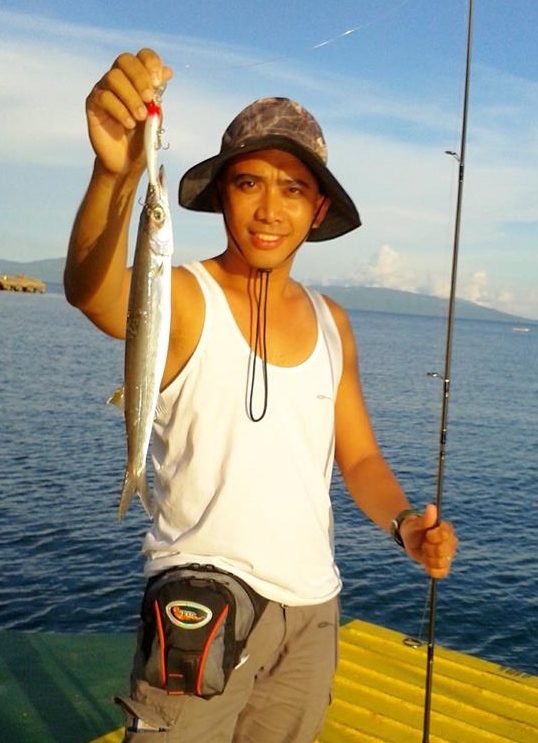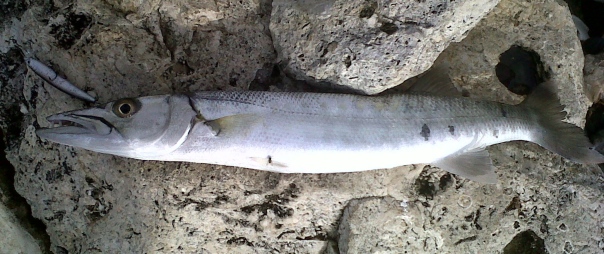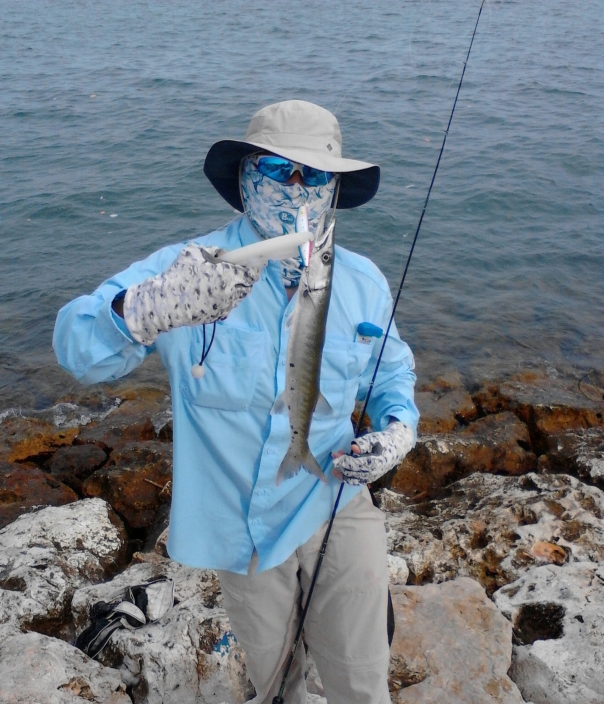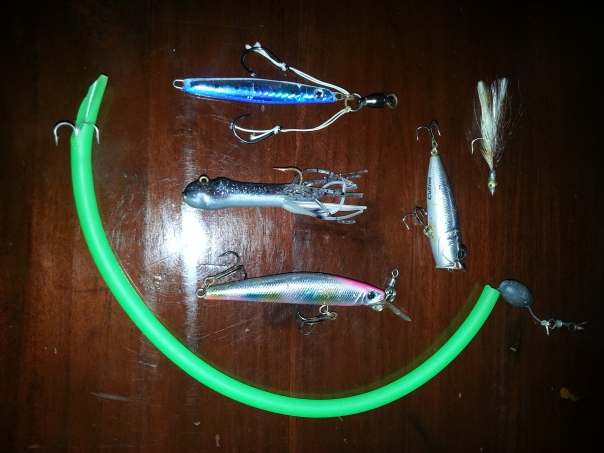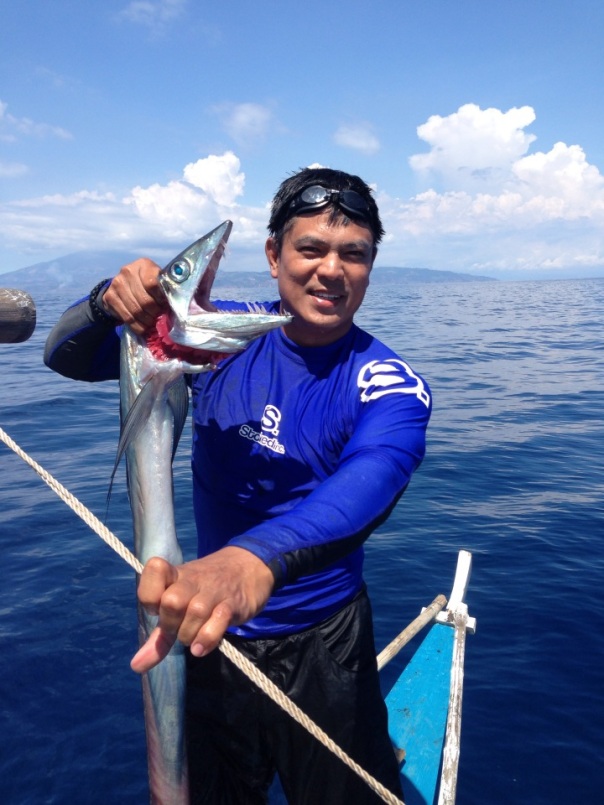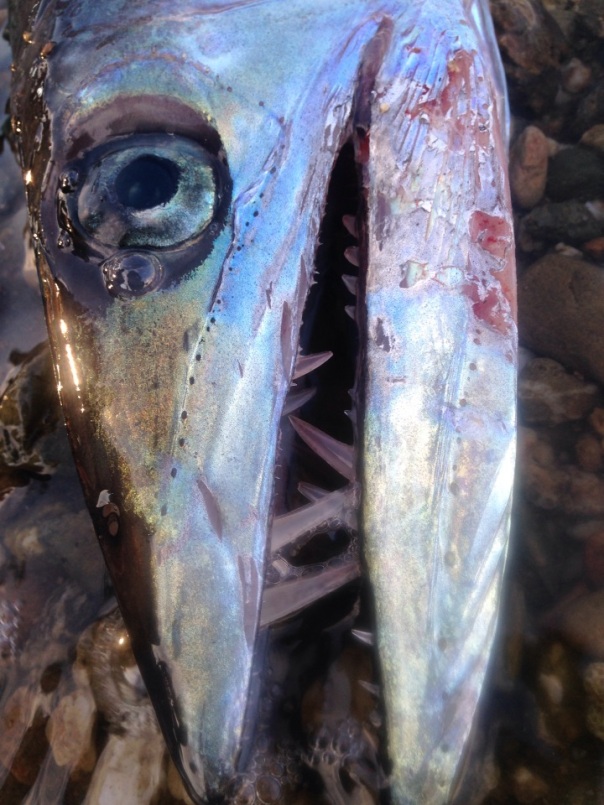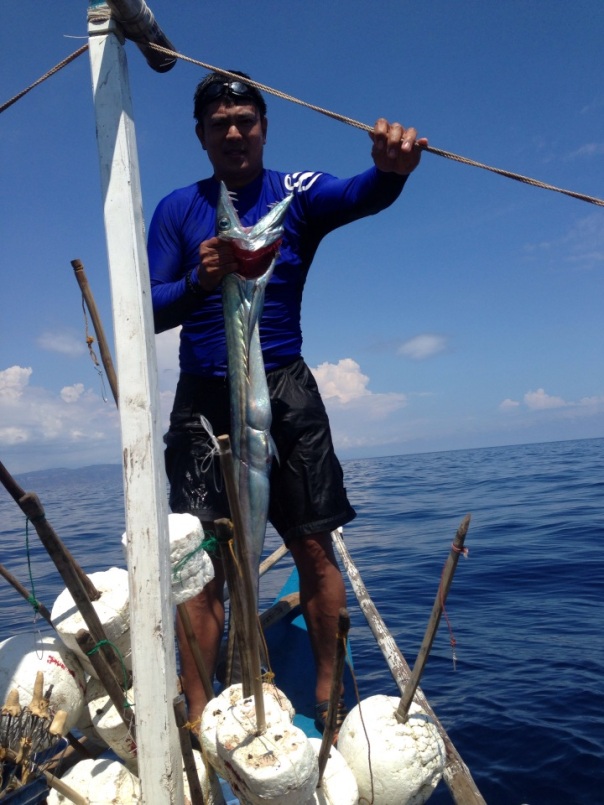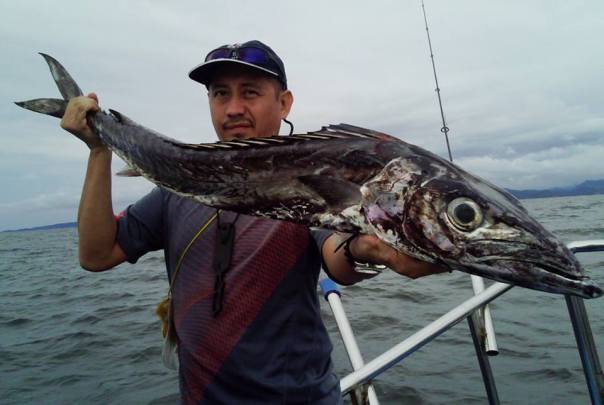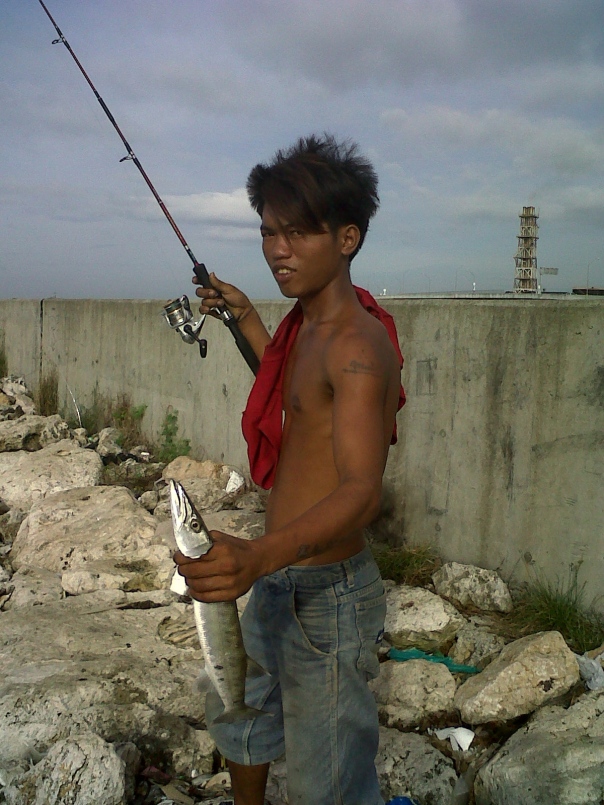Category Archives: Barracuda
Bigeye Barracuda ( Sphyraena forsteri )
Posted by benaiahfogle
Common Name: Barracuda, Javelin, Sea-Pike
Local Name: Turcilyo, Batig, Balyos (Tagalog) Tabangko (Cebuano)
Max Size: 75 cm
Biodiversity: Marine, Reef-Associated
Depth: 1 – 300 m
Fishing Season: All Year Long
Minimum Size Limit: None
Recommended Bait: Shrimp, Squid and Fish
IUCN Red List Status: Not Evaluated (NE)
The Bigeye Barracuda is another of the species from the Sphyraedinae genus. Their large eye is the most distguishing feature that helps in their identification. The Biegeye Barracuda are generally small in size and found in schools around reefs around the country. Anglers are likely to catch these fish while fishing small lures or bait such as shrimp or fish.
Posted in Barracuda
Barracuda Tackle and Tactics
Posted by benaiahfogle
This article is about fishing fishing for barracuda from shore with lures. Trolling for large barracuda is another article in itself for another time. Our hope is that anglers can learn a little more about this wonderful fish and experience the thrill of catching them on lures! Enjoy!
Barracuda are a torpedo shaped saltwater fish that can be found all around the world. There a couple species of Barracuda that are found in the Philippines of which the Great Barracuda ( Sphyrena barracuda ) is the most notable. Barracuda feed on just about any fish that they can manage to strike. They have razor sharp teeth which are notorious for their slicing capabilities. If is not uncommon for a baitfish to be severed in half by a strike from a barracuda. Barracuda have a silvery color with a dark barred back. In shallow water they can change the color of their bars from a dark almost black color to a light brown color that helps them blend into the sea floor.
Barracuda can be caught in a variety of marine environments. Smaller barracuda, called Juveniles, are mainly caught around reefs, estuaries, and coastlines, while the larger barracuda are usually caught around deeper reefs and offshore. Juvenile Barracuda often form large schools while larger adults are more solitary.
Tackle
A Medium to Medium/heavy lure casting setup will suffice for most barracuda and other coastal fish that can be caught around the Philippines on lures. Anglers here typically use 10 – 15lbs mono line or 12 – 30lbs braided line. More important than the size of main line used is the size of the leader line. A safe choice is a small section of solid or stranded trace wire. Fluoro and mono can be used and will be fine for most of the fish caught however occasionally cudas will strike a lure head on and slice neatly through even heavy mono and flouro.
Barracuda will strike almost any lure that is thrown at them. More important than the lure used is the type of retrieve used. Anglers usually have their preferred lures and colors which they feel work best. Some of the most commonly used lures include: soft plastic flukes, minnows and swimbaits; crankbaits, vibe lures, cuda tubes, spoons and jigs, feathers and flies, poppers and just about anything else :-). Catching barracuda on live and dead bait is an art that we will not discuss in this article.
Tactics
The retrieve is one of the most important things when fishing for barracuda. It can make the difference between no fish and no stop action. Barracuda can’t resist an injured looking fish that is trying to get away. The trick for anglers is to make their lures imitate that frantic action. Despite the Cudas preference to fleeing baitfish their preference seems to vary quite a lot day to day. We recommend that you try a variety of retrieves until you figure out what their interested in. Try a fast retrieve with brief pauses, or a slow sweeping rod movement with longer pauses in between. Slow retrieves with short sharp movements is also good.
By far the best time to fish for Barracuda is right around high tide. Barracuda will often sit in one area and not so much as look at passing fish until the tide changes. High tide usually draws the fish closer to shore to feed on small baitfish that are moving about in the tidal areas.
Because of their teethy mouths Barracuda can be difficult to land. Often the barracuda’s thrashing will dislodge a lure from their mouth and allow them to escape. Anglers call this spitting the hook.
Barracuda are great fun to fish for a variety of reasons. They readily strike just about any lure when the tide is right and do not require much knowledge, skill or technique in that regard. The smaller barracuda also move about in school and can often be caught in numbers. The violent thrashing strikes of Cudas also never get old. They are incredibly fast in the water and their sudden strikes often catch angler by surprise. It is also not uncommon for barracuda to strike feet or inches from shore. Barracuda will often use structures in the water to help corner fish from escaping.
Barracuda are edible and are their flesh is considered fair though it is not encouraged they can be kept and eaten. There is a risk of Ciguatera Poisoning when eating this fish because they are at the top of the food chain around reefs and often consumer smaller reef fish that have Ciguatera.
Fishing for barracuda can be useful along with fun because barracuda make great bait for deep sea fishing. Smaller cudas can be sliced into steaks and used to catch grouper, snapper and other deep sea species. Larger cudas can be filleted which can be sliced into strips.
Care needs to be exercised when handling barracuda, even small ones, because of their razor sharp teeth. Barracuda are not known to be the best fighting fish in the sea however they do often thrash about when they are handled. Tools such as needle nose pliers, hook removers and lip grips are handy to have when fishing for barracuda to keep your fingers from harm.
By Benaiah J Fogle
Posted in Barracuda
Longnosed Lancetfish ( Alepisaurus ferox )
Posted by benaiahfogle
Common Name: Lancetfish, Handsaw Fish, Wolffish
Local Name: Tokey, Diwit, Aswang (Tagalog); ?? (Cebuano)
Max Size: 215 cm (9 kgs)
Biodiversity: Marine, bathypelagic, oceanodromous
Depth: 1 – 1900 m
Fishing Season: All Year Long
Minimum Size Limit: none
Recommended Bait/Lures: Fish, Squid
IUCN Red List Status: Not Evaluated (NE)
Lancetfish are a unique strange looking fish that are capable of handling great extremes in pressure and temperature. They are able to feed at the surface all the way down to almost 2000 meters. They can also be found from the tropical seas all the way to the arctic. Their diet consists mainly of squid and fish and they are primarily a nocturnal fish. They resemble both Snake mackerel and Scabbardfish however they have noticeable differences than both.
The fish in these pictures was caught at around 300 meters depth off Paluan, Mindoro Island by Doc and was 3.8 kilos. He described the fish as having soft skin, two inch long long teeth and being called Tokey or Tukey by the locals there. They caught this fish while deep sea fishing for large squid.
Posted in Barracuda, Mackerel (Tangigue), Rare/Bizarre
Black Snoek ( Thyrsitoides marleyi )
Posted by benaiahfogle
Common Name: Snoek, Snake Mackerel, Blacksail Snake Mackerel, Barracauta
Local Name: Tanigueng Aswang (Tagalog), ??? (Cebuano)
Max Size: 200cm ( 6kgs kgs )
Biodiversity: Marine, Reef Associated, Oceanodromous
Depth: Surface – 400 m
Fishing Season: All Year Long
Minimum Size Limit: None
Anthony caught this bizarre fish on August 25, 2013 while deep water jigging. Apparently these fish takes good when fried. Snoek are deep water fish that often migrate too the surface at night to feed. They are normally found in school and feed on a variety to small fish and crustaceans. They put up a good fight and apparently often swim straight down or up during the fight.
Posted in Barracuda, Mackerel (Tangigue), Rare/Bizarre
Green Lagoon Park, Compostela, Cebu
Posted by benaiahfogle
Here is a spot that is located outside the city of Cebu just to the North in Compostela. This is a park style resort located along the coast in Compostela. Here is a map of the spot:
PROS:
Multiple spots within the resort to fish (jetties, beaches, etc.)
Parking for vehicles
You can bring food (grills/tables/chairs available there) and drinks for picnics
Family friendly atmosphere
Clean water
Separate areas to swim
CONS:
There can be lots of people from time to time
Entrance fee
DESCRIPTION:
This is a laid back family and large group oriented resort located along the Compostela coastline. It has three stone and concrete jetties protecting its two rock and sand beaches. You can fish on all three jetties. The sea floor gradually slopes deeper away from the beach, however the reef wall is looked well beyond casting distance. The bottom is rocky and sandy. You can bring food and drinks into this resort, so it makes a great spot to take the family for the day.
FISH SPECIES:
Barracuda, Grunters, Emperors, and more. The ones I listed here were what I caught when fishing and what I saw when I did a little snorkelling. There are also some mangroves and a small stream leading to the ocean on the northern side of the resort.
RATING:
( 8/10 ) This is not a bad place to fish. It is a little bit of a drive from the City through and did not seem to have lots of fish so I give it an 8.
REMINDERS:
Fish Responsibly – Catch and Release and clean up after yourself
Bring sun protection because there is little shade in the spots where you fish
Be aware of the swimmer/snorkelers
Bring lures and bait
I Visited this place with some friends, family and co-workers and was able to bring along some fishing gear. Hooked this nice little barracuda after about five minutes of fishing. Try to catch the high tide as it goes out to catch barracuda like this and other species.
Posted in Barracuda, Fishing Spots
Cuda On The High
Posted by benaiahfogle
Went out this morning early after my morning devos. Spent an hour casting my little pins over near the Carbon Market during high tide. I hooked this nice barracuda not long after I started to the delight of my self and Gilbert (a tag along from the market). I learned from Gilbert that barracuda are called Rumpi down here in Cebu. He told me this one was a “baby” and that fishermen sometimes bring in massive Rumpi when they come back from fishing in the Laud (open ocean). This one was a fun fish to catch and I donated it to Gilbert because he rescued my little pins from a snag 🙂
Juvenile Sphyraena Barracuda
Posted by benaiahfogle
I believe this is a juvenile sphyraena Barracuda, or Great Barracuda. There are many of these in the water around Porter and they are quick to inspect and sometimes bite just about anything that is thrown in the water. They tend to be a bit cautious so it is not uncommon to fish porter all day and have these cud’s chase your lures all day, but stop just before striking. Sometimes you fish the whole day and only get one fish. There are some big one here and I have heard of a friend catching one here around 5kgs.
Posted in Barracuda

